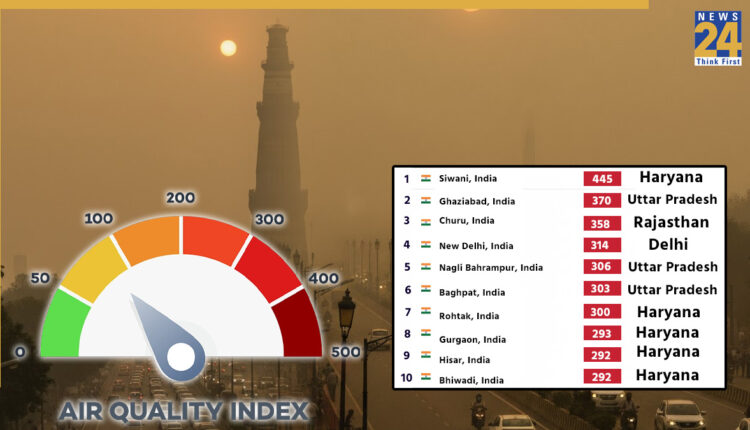Air Quality Index in Delhi NCR continues to stay in the red zone as a combination of pollution, fog, and low wind speeds leads to persistent haze in Delhi, NCR, and other regions. According to the Air Quality Index (AQI) measured at 10:30 am on November 3, 2025, all 25 of the world’s most polluted cities were located in India—a concerning development for citizens who may face prolonged health issues due to exposure to high levels of pollution. While Delhi is often considered the epicenter of pollution in overall rankings, the city has dropped out of the top 10, with several other cities showcasing even higher AQI levels.
AQI in Delhi NCR
Delhi’s air quality stayed in the ‘very poor’ category on Sunday, touching a seasonal high of 388 at 10 a.m., and the city is expected to record the year’s first ‘severe’ air day this week. At 4 p.m., the average Air Quality Index (AQI) marginally improved as the winds picked up speed during the day, registering 366 at 4 p.m., when the Central Pollution Control Board (CPCB) released its daily national bulletin. However, at least five individual active ambient air quality stations recorded AQIs in the ‘severe’ category.
Long-term trends indicate that Delhi has entered its most polluted phase of the year. A Delhi Pollution Control Committee (DPCC) analysis of CPCB data found that November 1–15 has consistently recorded the highest AQI levels annually, followed by December 16–31.
On Sunday, by 4 p.m., five of the 39 active monitoring stations had slipped into the ‘severe’ zone — Burari, Chandni Chowk (404), RK Puram (401), Vivek Vihar (402), and Wazirpur (418). Another 30 stations were in the ‘very poor’ range, CPCB data showed.
Meteorologists attributed the worsening air to low wind speeds and weather conditions that often trap pollutants close to the surface. Winds picked up slightly to around 10 km/hr during the day, which briefly helped improve air quality.
Data from the Decision Support System (DSS), which identifies major pollution sources, showed that transport was the largest contributor to Delhi’s PM2.5 load at 18.1%, followed by emissions from Jhajjar district (11.2%) and Delhi’s residential sector. About 36.8% of the particulate matter came from regional sources outside Delhi that are unaccounted for. The contribution from stubble burning stood at 3.5% on Sunday, down from 9% a day earlier.
The concentration of PM2.5 was critically high on Sunday morning. Several stations such as Nangloi, Ashok Vihar, Burari, Narela, Rohini, Vivek Vihar, and Wazirpur reported hourly PM2.5 levels between 400 and 459 µg/m³.
Noida’s Air Quality
A thick layer of smog persisted over Noida as the air quality deteriorated further. According to data on the CPCB portal, Noida’s average AQI stood at 348, a notable deterioration from 292 the day before.
Greater Noida and Ghaziabad both showed the same trend, with air quality slipping to 340 and 351, respectively, down from 265 and 298.
Station-wise data showed that Noida’s air quality remained in a ‘very poor’ state on Sunday. Sector 125 recorded the worst AQI at 352, followed by Sector 116 (348), Sector 1 (338), and Sector 62 (332). In Greater Noida, both Knowledge Park III (337) and Knowledge Park V (327) recorded ‘very poor’ air quality.
How Temperature Decline Leads to Smog
Changing weather patterns often trap pollutants close to the surface as temperatures decline. The situation is further worsened when wind speeds are low. Burning residue from agricultural practices and debris from construction sites intensifies the problem.
Stubble burning has, over time, been a major contributor to overall pollution. The pollution from stubble burning often drifts into neighboring states such as UP, Punjab, and Haryana, affecting nearby cities. Additionally, transport vehicles further add to the pollution load, which the government has been planning to reduce with schemes like GRAP 2.
Industrial air pollution is another significant contributor to overall pollution levels.
Air pollution can lead to intensified health issues. It is therefore advised to reduce outdoor activities and wear a mask to minimize exposure to harmful pollutants in the air.

